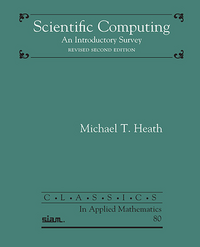Numerical Analysis (CS 450) Spring 2025
| What | Where |
|---|---|
| Time/place | Tue/Thu 11:00am--12:15pm 1404 Siebel Center for Computer Science / Catalog |
| Class recordings | Illinois Mediaspace |
| Lecture 5 Re-recording | Illinois Mediaspace (Lec5 w/ Audio) |
| Lecture 10 Re-recording | Illinois Mediaspace (Lec10 w/ Audio) |
| Discussion | Discuss » |
| Administrative Help | Help Desk (click "Message" on the top right) |
| Chat | Chat » |
| Calendar | View » |
Office Hours
Office hours will be held in the tutoring space in the basement of Seibel
- Monday
- 4:00-5:00 PM Ruining Zhao
- Tuesday
- 12:30-1:30 PM Paul Fischer
- Wednesday
- 2:00-4:00 PM Jonathan Wang
- 7:00-8:00 PM Hansheng (Hansen) Liu (Online, Zoom Meeting ID: 837 0768 1158 Passcode: 11450)
- Thursday
- 12:30-1:30 PM Paul Fischer
- Friday
- 1:00-2:00 PM Hansheng (Hansen) Liu
- 2:00-3:00 PM Ruining Zhao
Quizzes
- Quiz for lecture 02
- Quiz for lecture 03
- Quiz for lecture 04
- Quiz for lecture 05
- Quiz for lecture 06
- Quiz for lecture 07
- Quiz for lecture 08 (Due 11 AM, Friday, Feb. 14)
- Quiz for lecture 09
- Quiz for lecture 10 (Due 11 AM, Friday, Feb. 21)
- Quiz for lecture 11
- Quiz for lecture 12
- Quiz for lecture 13
- Quiz for lecture 14
- Quiz for lecture 15
- Quiz for lecture 16 (Due 11 AM, Friday, Mar. 14)
- Quiz for lecture 17
- Quiz for lecture 18
- Quiz for lecture 19
- Quiz for lecture 20 (Due 11 AM, Friday, Apr. 4)
- Quiz for lecture 21
- Quiz for lecture 22
- Quiz for lecture 23
- Quiz for lecture 24
- Quiz for lecture 25
- Quiz for lecture 26
- Quiz for lecture 27
- Quiz for lecture 28
Homework
- Homework set 1 (Due January 29)
- Homework set 2 (Due February 5)
- Homework set 3 (Due February 19)
- Homework set 4 (Due February 26)
- Homework set 5 (Due March 25)
- Homework set 6 (Due March 28)
- Homework set 7 (Due April 11)
- Adv. HW 1 for 4-cr (
Due April 18Extended to April 25) - Homework set 8 (Due April 16)
- Homework set 9 (Due April 30)
- Adv. HW 2 for 4-cr (Due May 2)
Exams
Please find information on our upcoming exams below. Reserve your time slots in the testing facility early after the posted self-reserve time--otherwise your preferred times may no longer be available.
- Exam 1 duration: 50 min cbtf_start: 02-11 cbtf_end: 02-13 23:59:00 (CST) cbtf_self_reserve: 01-30 (CST)
- Exam 2 duration: 50 min cbtf_start: 03-04 cbtf_end: 03-06 23:59:00 (CST) cbtf_self_reserve: 02-20 (CST)
- Exam 3 duration: 50 min cbtf_start: 04-01 cbtf_end: 04-03 23:59:00 (CDT) cbtf_self_reserve: 03-13 (CDT)
- Exam 4 duration: 50 min cbtf_start: 04-22 cbtf_end: 04-24 23:59:00 (CDT) cbtf_self_reserve: 04-10 (CDT)
-
Final duration: 1h 50m cbtf_start: 05-08 cbtf_end: 05-15 23:59:00 (CDT) cbtf_self_reserve: 03-14 (CDT)
Course Outline
- Introduction to Scientific Computing
- Systems of Linear Equations
- Linear Least Squares
- Eigenvalue Problems
- Nonlinear Equations
- Optimization
- Interpolation
- Numerical Integration and Differentiation
- Initial Value Problems for ODEs
- Boundary Value Problems for ODEs
- Partial Differential Equations and Sparse Linear Algebra
- Additional Topics
- Chapter 01 (Last updated: Jan. 28, 2025)
- Chapter 02 (Last updated: Feb. 06, 2025)
- Chapter 03 (Last updated: Feb. 18, 2025)
- Chapter 04 (Last updated: Feb. 27, 2025)
- Chapter 04a (Last updated: Mar. 04, 2025)
- Chapter 05 (Last updated: Apr. 3, 2025)
- HW5 Hint (Last updated: Mar. 23, 2025)
- Chapter 06 (Last updated: Apr. 1, 2025)
- Chapter 07 (Last updated: Apr. 10, 2025)
- Chapter 08 (Last updated: Apr. 17, 2025)
- Chapter 09 (Last updated: Apr. 29, 2025)
- Chapter 10 (Last updated: Mar. 1, 2025)
Team




Statement on CS CARES, Values, and Code of Conduct
All members of the Illinois Computer Science department---faculty, staff, and students---are expected to adhere to the CS Values and Code of Conduct. The CS CARES Committee is available to serve as a resource to help people who are concerned about or experience a potential violation of the Code. If you experience such issues, please contact the CS CARES Committee. The instructor of this course are also available for issues related to this class.
Textbook

Scientific Computing: An Introductory Survey / E-Book (accessible free of charge from campus network/VPN)
Michael T. Heath, Revised Second Edition, Society for Industrial and Applied Mathematics
Computing
We will be using Python with the libraries numpy, scipy and matplotlib for in-class work and assignments. No other languages are permitted. Python has a very gentle learning curve, so you should feel at home even if you've never done any work in Python.
Running Code on your Own Computer
While running code in this online system should technically suffice to do your work for this class, you may find it useful to also install Python on your own computer.
The recommended way of doing so involves downloading the Anaconda Python distribution. Note that this is a commercial product (even if it is free of charge), and this is not intended as an endorsement of the company or the product. Note that we cannot promise to provide technical support for this installation.
Another way to run Python code is through an online JupyterLab available through the course. Go to https://relate.cs.illinois.edu/lab get started. NOTE that this environment runs entirely in your browser. If you clear your browser data, any work 'saved' there will be irretrievably lost.
Grading Policies
Python Help
- Python tutorial
- Facts and myths about Python names and values
- Learn Python the hard way
- Project Euler (Lots of practice problems)
- PythonTutor (Execute Python step-by-step, with pictures)
Numpy Help
(see section 1 of the outline for more)
- From Python to Numpy
- With associated 100 numpy exercises
- The SciPy lectures
- The Numpy User Guide
- More in this reddit thread
- An introduction to Numpy and SciPy